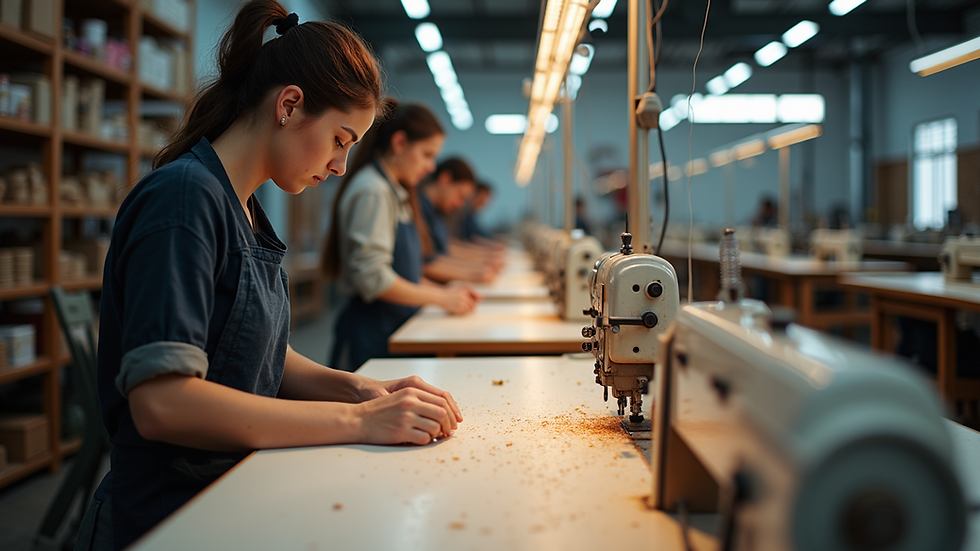Top Trends in Textile Industry: Expert Insights
- JAWAD HADI
- Aug 7
- 3 min read
The textile industry is constantly evolving, influenced by technology, consumer preferences, and sustainability concerns. As we step into a new era, it is essential to understand the trends shaping this dynamic field. From innovative materials to sustainable practices, the textile industry is undergoing significant changes. In this blog post, we will explore the top trends in the textile industry, providing expert insights and practical examples to help you stay informed.
Sustainability Takes Center Stage
Sustainability is no longer just a buzzword; it is a fundamental aspect of the textile industry. Consumers are increasingly aware of the environmental impact of their purchases. As a result, brands are adopting sustainable practices to meet this demand.
Eco-friendly Materials: Many companies are turning to organic cotton, hemp, and recycled polyester. These materials reduce the carbon footprint and minimize waste.
Circular Fashion: The concept of circular fashion encourages recycling and reusing textiles. Brands like Patagonia and Eileen Fisher are leading the way by offering take-back programs and promoting second-hand shopping.
Water Conservation: Innovative dyeing techniques, such as digital printing, use significantly less water than traditional methods. This shift is crucial in regions facing water scarcity.
Sustainability is not just a trend; it is a necessity for the future of the textile industry.
Technological Advancements
Technology is revolutionizing the textile industry in various ways. From production to retail, advancements are making processes more efficient and enhancing the consumer experience.
Smart Textiles: Wearable technology is on the rise. Fabrics embedded with sensors can monitor health metrics, such as heart rate and temperature. Companies like Athos are creating workout gear that tracks performance.
3D Printing: This technology allows for rapid prototyping and customization. Designers can create unique patterns and shapes that were previously impossible. Brands like Adidas are experimenting with 3D-printed shoes, offering personalized fit and style.
Blockchain for Transparency: Consumers want to know where their products come from. Blockchain technology provides a transparent supply chain, allowing brands to trace the origin of materials. This builds trust and accountability.
Technological advancements are not just enhancing production; they are also transforming how consumers interact with textiles.
The Rise of Personalization
In today's market, consumers crave individuality. Personalization is becoming a key trend in the textile industry, allowing brands to cater to unique preferences.
Customizable Products: Brands like Nike and Converse offer customization options for shoes and apparel. Customers can choose colors, patterns, and even add their names.
Data-Driven Design: Companies are using data analytics to understand consumer preferences better. This information helps brands create products that resonate with their target audience.
On-Demand Production: Instead of mass production, brands are shifting to on-demand manufacturing. This approach reduces waste and allows for more personalized offerings.
Personalization is not just a trend; it is a way to connect with consumers on a deeper level.
Ethical Labor Practices
As consumers become more conscious of their purchases, ethical labor practices are gaining importance. Brands are being held accountable for their supply chain practices.
Fair Wages: Companies are increasingly ensuring that workers receive fair wages. Brands like Everlane are transparent about their pricing and the wages paid to workers.
Safe Working Conditions: Ensuring safe working environments is crucial. Brands are investing in audits and certifications to guarantee ethical practices.
Community Support: Many brands are giving back to the communities where they source materials. This support can take the form of education, healthcare, or infrastructure development.
Ethical labor practices are essential for building a responsible and sustainable textile industry.
The Influence of Social Media
Social media is reshaping how brands market their products and engage with consumers. Platforms like Instagram and TikTok are powerful tools for the textile industry.
Influencer Collaborations: Brands are partnering with influencers to reach wider audiences. These collaborations can create buzz and drive sales.
User-Generated Content: Encouraging customers to share their experiences on social media can enhance brand loyalty. Companies often feature user-generated content on their platforms, creating a sense of community.
Trend Forecasting: Social media trends can influence design and production. Brands are closely monitoring platforms to stay ahead of consumer preferences.
The influence of social media is undeniable, and it continues to shape the textile industry in exciting ways.
Conclusion: Embracing the Future of Textiles
The textile industry is at a crossroads, with sustainability, technology, personalization, ethical practices, and social media driving change. As we move forward, it is crucial for brands to adapt to these trends to remain relevant and meet consumer demands.
By embracing sustainability and innovation, the textile industry can create a brighter future. Whether you are a consumer, designer, or manufacturer, staying informed about these trends will help you navigate the evolving landscape of textiles.

As we look ahead, the possibilities are endless. The textile industry is not just about fabric; it is about creating a positive impact on the world. Let us embrace these trends and work together towards a more sustainable and innovative future.


Comments